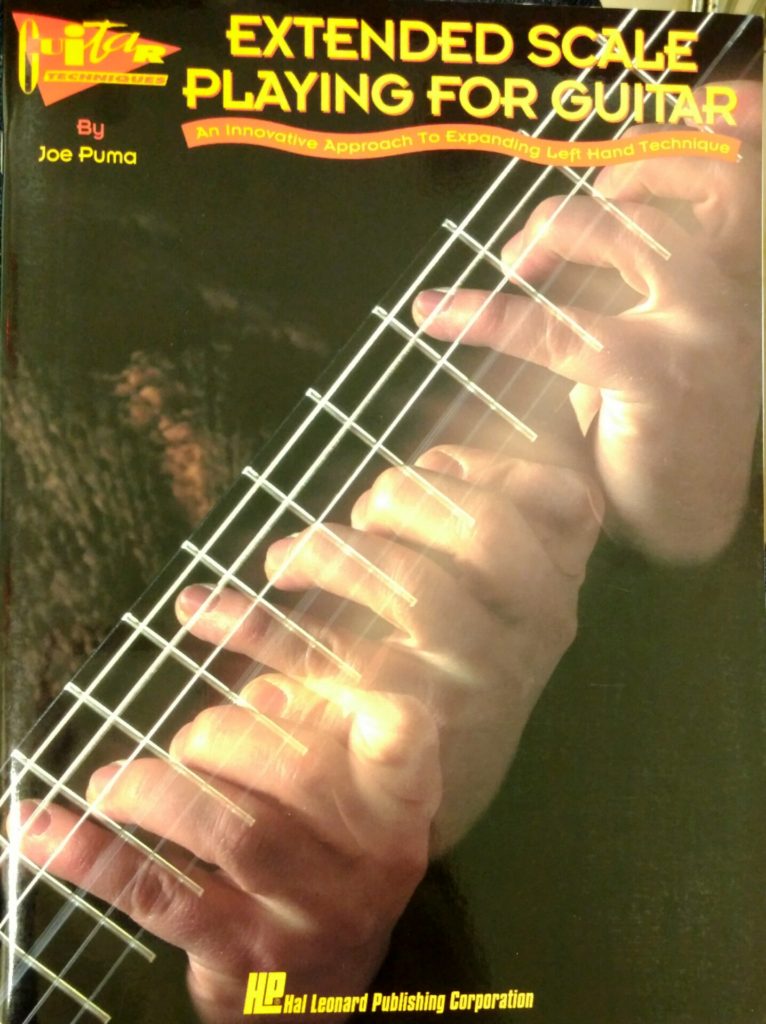
This 48-page book by Joe Puma is from a Guitar Techniques series by Hal Leonard. First published in 1993, the copy I have is the second printing from March 1995. Joe Puma builds the foundation of the entire book on the premise that you can extend the length of scale fingerings via first finger half step shifts. It’s a simple idea and is elegant because of that!
I would recommend this book for guitarists who are already comfortable with perhaps a CAGED system approach or 3-note per string approach and would like to connect their scales smoother. My initial impression when I first saw this book was that it’s pretty cool but I already was doing some of this intuitively. The question was: Do I still buy this book? I did and it’s because as a reference it quickly allows me to find a practice routine or new scale fingering to explore.
For guitarists new to this, I believe working through a page for 1 to 3 days could be a good practice routine. Joe Puma doesn’t just list the fingerings but also gives some exercises as well as variations on the scale fingerings starting on different scale degrees.
For more experienced guitarists and music educators, I think this book is a worthy addition to your reference library.
Cons: Might require an understanding of standard scale systems to really benefit from the book.
TLDR: If you like geeky scale practice concepts and want to expand your fretboard visualisation skills, get this book. If you don’t have any scale fingering books or don’t have a strong foundation for scales, my main recommendations would be either Martin Miller’s Improvisation Masterclass Vol. 1 (a very in-depth work with video, PDF files and both CAGED and 3-note per-string approaches to scale & fretboard visualisation) or Six Essential Fingerings for the Jazz Guitarist by Jimmy Bruno (a simpler approach).
How to Buy:
I bought this book from Swee Lee Music (free shipping to Singapore and Malaysia). It currently appears to be not available there anymore. Amazon has copies in stock: https://www.amazon.com/EXTENDED-SCALE-PLAYING-GUITAR-Puma/dp/0793516862
[Read more Book Reviews]
[Submissions for Review Consideration]
- Are you an author who wrote a jazz or music book?
- Have you created a DVD or an online video course or subscription based website?
- Would you like me to review your book/course?
Please send me a message at azsamad2 at gmail.com with:
For courses: a link to the course/video/product + access info etc.
For books: a link to the book (Dropbox) or PDF attachment (if it’s small) for review consideration.
Depending on whether I dig the book/course, I’ll let you know if I do plan to review it!
I cannot guarantee a review for every submission & if I’m not too into it, I may opt not to review it. I mean, it’s better to get a good review that for me to write a bad review just because it’s not a match for the kind of stuff I dig right? :p
NOTE: All reviews reflect my honest personal opinion so be aware that I will point out both cool Pros and Cons that I see in the work. You dig? 🙂